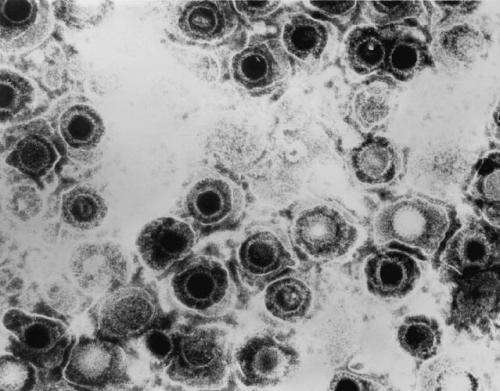Cryo-electron microscopy reveals common herpes virus structure

For the first time, researchers have been able to use cryo-electron microscopy, to reveal the detailed structure of the common herpes virus.
Researchers at the University of Glasgow used the cutting-edge technique to reveal, in high resolution, the biological mechanisms the herpes virus uses to infect people. The findings are published today in PLOS Biology.
The researchers now hope that these findings could lead to the development of new drugs to treat the virus.
The herpes family include the viruses that cause both cold-sores and chicken pox. Members of this family of viruses can also cause cancers and severe illnesses in the unborn child.
However, at only 1/10,000th of a millimetre in diameter, the capsid – or shell – the herpes virus uses to store its DNA and infect its host, has until now been difficult for scientists to anaylse.
Herpes viruses cause infection by introducing their DNA into our cells. To do this, they package their DNA inside a protective coat called a capsid. The capsid is spherical in shape and highly symmetrical.
The researchers used cryo-electron microscopy to reveal the structure of a motor-like assembly called a portal. Herpesviruses pump their DNA into preassembled capsids through the portal. When a herpes virus infects our cells, the DNA is ejected from the capsid by the same portal machinery.
Dr. David Bhella, lead author of the study from the MRC-University of Glasgow Centre for Virus Research, said: "Cryo-electron microscopy, combined with new computational image processing methods allowed us to reveal the detailed structure of the unique machinery by which the virus packs DNA into the capsid. The DNA is packed very tightly, reaching a pressure similar to that inside a bottle of Champagne.
"We hope that this study will eventually lead to the development of new medicines to treat acute herpesvirus infections, through the design of drugs that will block the action of the portal motor."
As well as revealing the shape of the portal machinery, this study also revealed how the virus packs its DNA inside the capsid. Individual strands of DNA were seen to be wound up in a spool, rather like a ball of wool.
The development of cryo-EM as a technique for resolving detailed atomic structures was developed at the MRC Laboratory of Molecular Biology.
Dr. Jonathan Pearce, Head of Infections and Immunity at the MRC, said: "Dr. Bhella and his team have now used this technique to elucidate the structure of the herpes virus, revealing a 'molecular machine' that is involved in virus replication. The findings provide scientists with a better understanding of the virus and its anatomy, and, in turn, an insight into potential new therapeutic targets.
"These elegant experiments exemplify the potential of the Scottish Centre for Macromolecular Imaging due to be launched later this year at the CVR, led by Dr. Bhella, which will support vital research into diseases posing the greatest threat to human health."
The study, "Structure of the herpes-simplex virus portal-vertex" is published in PLOS Biology.
More information: Marion McElwee et al. Structure of the herpes simplex virus portal-vertex, PLOS Biology (2018).
Journal information: PLoS Biology
Provided by University of Glasgow



















